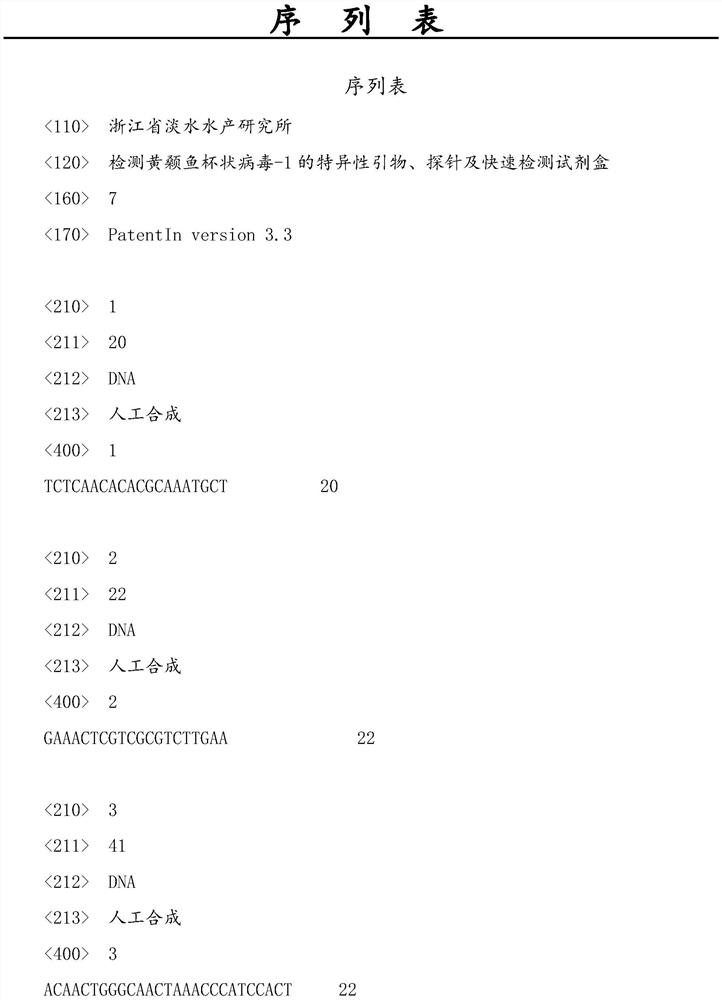Specific primer, probe and rapid detection kit for detecting pelteobagrus fulvidraco calicivirus-1
A calicivirus, primer probe technology, applied in the field of rapid detection of target RNA fragments, can solve problems such as hindering disease early warning and prevention
- Summary
- Abstract
- Description
- Claims
- Application Information
AI Technical Summary
Problems solved by technology
Method used
Image
Examples
Embodiment 1
[0028] A primer-probe mixture for detecting yellow catfish calicivirus-1, which consists of primer set A and Taqman fluorescent probe B, the 5' end of probe B is labeled with a fluorescent reporter group, and the 3' end is labeled with a fluorescent quencher group.
[0029] The primer set A includes primer YCCV-1-q183F and primer YCCV-1-q183R;
[0030] The primer YCCV-1-q183F sequence is shown in SEQ ID NO: 1;
[0031] The primer YCCV-1-q183R sequence is shown in SEQ ID NO: 2;
[0032] The nucleotide sequence of the probe B is shown in SEQ ID NO:3.
[0033] Wherein, the fluorescent reporter group is selected from 6-carboxyfluorescein, hexachloro-6-methylfluorescein, VIC fluorescent dye, tetrachloro-6-carboxyfluorescein, carboxyl-X-rhodamine, 6-carboxytetramethyl Rhodamine, sulforhodamine, 6-carboxy-4', 5'-dichloro-2', 7'-dimethoxyfluorescein succinimide ester, cyanine 3, cyanine 3.5, cyanine 5 and one or more of cyanine 5.5; the fluorescence quenching group is selected fro...
Embodiment 2
[0039] Yellow catfish calicivirus-1 fluorescence quantitative detection kit, including individually packaged viral nucleic acid extraction solution, one-step RT-qPCR reaction solution, positive quality control material, negative quality control material and primer-probe mixture.
[0040]The primer-probe mixture is composed of primer set A and Taqman fluorescent probe B, wherein the final concentration of upstream and downstream primers of primer set A is 0.15 μM, and the final concentration of probe is 0.1 μM.
[0041] Taqman fluorescent probe B, its nucleotide sequence is labeled with HEX at the 5' end and BHQ1 at the 3' end;
[0042] The negative quality control product is sterile saline without RNase; the positive quality control product uses the purified yellow catfish calicivirus-1 genome as the template, and is amplified by RT-PCR with primer set A, and the amplified product is connected to the vector , the pseudovirus obtained by packaging after being confirmed to be co...
Embodiment 3
[0046] Yellow catfish calicivirus-1 fluorescence quantitative detection kit was applied, take 0.05g of the sample to be tested and add 1mL of virus nucleic acid extract to fully grind, centrifuge at 12000r / min for 10min, take 800uL of supernatant, add 400uL of ethanol, and after 5min at room temperature , centrifuge at 12000r / min for 5min, wash the precipitate once with 75% ethanol, dry at room temperature for 5min, add 50uL DEPC water to dissolve the RNA, take 5uL into the reaction tube, add 2uL of primer-probe mixture, and then add one-step RT - 10uL of qPCR reaction solution, add 3uL of DEPC water, mix well and perform fluorescence quantitative PCR. The reaction conditions are 42°C for 20 minutes, 95°C for 5-10 minutes; then 95°C for 5-15 seconds, 60°C for 20 minutes -45 seconds, a total of 45 cycles; the fluorescence signal collection is set to HEX, and the fluorescence signal collection is set to 60 °C;
[0047] Result judgment:
[0048] If there is no S-shaped amplifica...
PUM
 Login to View More
Login to View More Abstract
Description
Claims
Application Information
 Login to View More
Login to View More - R&D
- Intellectual Property
- Life Sciences
- Materials
- Tech Scout
- Unparalleled Data Quality
- Higher Quality Content
- 60% Fewer Hallucinations
Browse by: Latest US Patents, China's latest patents, Technical Efficacy Thesaurus, Application Domain, Technology Topic, Popular Technical Reports.
© 2025 PatSnap. All rights reserved.Legal|Privacy policy|Modern Slavery Act Transparency Statement|Sitemap|About US| Contact US: help@patsnap.com



